Ranking in digital marketing typically refers to the position at which a website or webpage appears in the search engine results pages (SERPs) for specific keywords or search queries. When someone searches for a particular term, search engines like Google display a list of relevant websites, videos, and other content ranked in order of perceived relevance and authority.
When ranking on a person’s name or a brand name in digital marketing, it usually involves optimizing online content to ensure that it appears prominently when someone searches for that specific name. This can be important for personal branding, reputation management, or promoting a business.
But why would you want to rank on your name or someone else’s name? Here’s why:
Online Visibility and Trust
Ranking prominently on a person’s name helps increase their online visibility and builds trust with their audience. When individuals can easily find accurate and relevant information about someone, it enhances their perceived authority, expertise, and trustworthiness.
So if I search for Dennis Yu, I want to control what shows up. So almost everything on the first page of Dennis Yu is me, even though there are a lot of people named Dennis Yu, and there are 38 million search results, which is competitive:
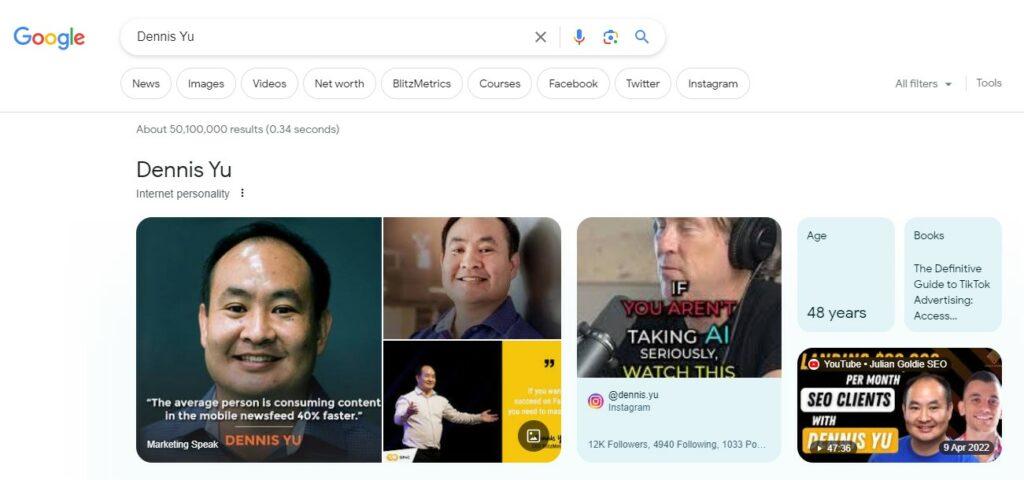
So you can also see my knowledge panel.
There would also be videos, those that you made and also videos that feature you or have you in the name, such as the one below where I am with Tom Ferry on Tom Ferry’s channel, and my name’s in it:
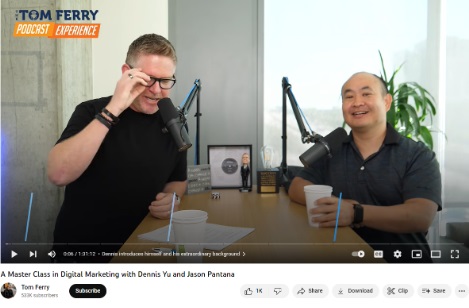
Google will even pull out particular moments or highlights that you can make more content around.
If you dominate the first page, it’s harder for somebody to write a negative review about you because they have to get past all your good results.
Even if you don’t have someone attacking you, you always want to be preemptive. The strongest defense is the best offense, and vice versa.
If you’re trying to rank on any keyword, look at ‘Related Searches’ or ‘People Also Ask (PAA)’ to see if we can rank on the secondary searches to be then able to rank on the big searches as they tie together.
So what do people look for in Dennis?


They want to know my net worth, about Content Factory, about dollar-a-day. So Google is showing us what these related terms are as well.
When your name appears in the PAA, that’s basically an endorsement by Google. It’s more powerful to show up here than it is for you to rank on this.
Brand Management
Ranking on a person’s name allows them to have control over the information that appears in search results. It enables them to present their achievements, expertise, and positive content while minimizing the visibility of negative or irrelevant information.
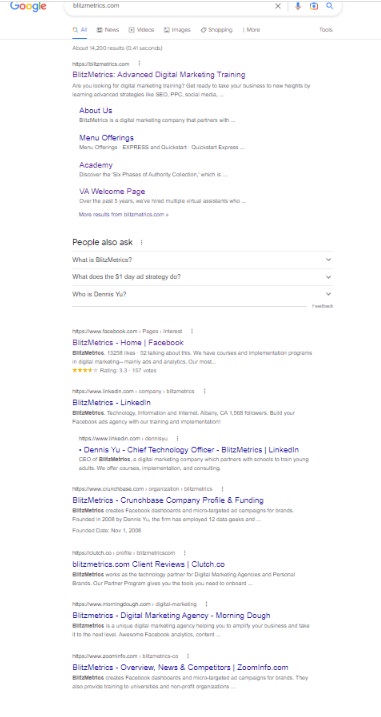
You can see that we dominate on courses. And we have site links, and I want to say the maximum is eight. So the more trust you have, the more site links you can have.
Though you can’t control how many site links Google gives you, generally, the more authoritative you are, the higher your domain authority, and the more of these you’re going to get.
So I’d encourage you to Google your name, look at how many there are when you do a phrase match, and look at how many there are when you do a title search. And that should give you a sense of competition.
Networking and Connections
Having a high ranking on a person’s name can facilitate networking and building connections with others in the industry. When people search for the person’s name, they can easily find their online profiles, websites, or social media accounts, allowing for meaningful engagement and collaboration.
But here’s a sophisticated technique called inception to leverage another person’s high-ranking name in your niche to increase your own network.
Let’s say there’s someone in your industry that you want to get to know better, but you don’t really have a great connection with them.
For example, you wanted to build your career with Mari Smith, whose search results show that she’s the queen of Facebook, blogging, Instagram, and Wikipedia and that she had written the original books on how to network and how to do social media reputation even before there ever was social media.
Don’t just straight up make a connection request. You want to make sure that you build a little bit of rapport. Just like when you want to marry a girl. You don’t just go straight to her and say, “Will you marry me?” You need to build that relationship over time.
So whoever you want to meet, stalk them on every single channel. Stalking doesn’t mean that you immediately reach out and say, “Hey, I’d like to have a five-minute chat with you”. The professional way is for you to ‘follow’ her on different channels.
Start to say something thoughtful about the topic she cares about, follow her on all her channels, and figure out who that intermediate person is- a mutual friend.
For example, I noticed she is also connected with my friend, Michael Stelzner, with whom I have made content. So, for a Dollar a Day on Twitter, I’ll promote a very popular content that I created with Michael Stelzner on the topic, ‘Facebook Algorithm Explained for Marketers’, targetting Mari Smith fans and saying, “Facebook isn’t as cool to the kids, but the algo is still as powerful as ever.
So, I’m sharing valuable content. It’s still worthwhile at the surface level, but I’m trying to build influence on the second level. So I’ll run ads against that content for a dollar a day, targeting her audience because I want them to see that I’m doing stuff with Michael Stelzner. So the way to get to somebody is to go to the other person, the gatekeeper.
It’s the same networking strategy. We’re just doing this digitally.
Marie Smith will probably see the tweet because her fans see it. They’ll engage on it. If my content is good and I’m using the ad system to network for me, that tweet will likely show up almost promptly when you search my name.
This is how you build connections using social and SEO at the same time. SEO is the result. If I want to rank on Google, I might have to do certain things like do social media or create content or do these other things with the result being SEO.
Thought Leadership
Ranking well on a person’s name enables them to establish themselves as a thought leader or industry expert. By creating and sharing valuable content, participating in relevant discussions, and being visible in search results, they can position themselves as a go-to authority in their field.
So, let’s say I’ve developed a relationship with Mari Smith; I could then go to her and say, “Hey Mari, I’ve got this article coming out on optimization. You’re the queen of Facebook. Can you give me one tip that I can put in my article?”, or, “I am bringing out the next edition of the best selling book on TikTok Advertising, what is your one tip for people that are Facebook advertisers but are trying to move to TikTok?” They almost always say yes.
If any of these people rank on the thing that I want to rank on, and Google trusts them, when I quote them, that will naturally send a powerful, relevant, familiar signal. And when they link to me, I’m getting juice from something that Google already believes is trustworthy when it comes to digital marketing optimization.
You can think of it as an edge, and social networks and search engines follow something called Edge rank, which is the connection between these different pieces. So Google looks for these connections; if we put together Mari Smith and Dennis Yu, where are those connections? So the more you associate with these other people, the more you’ll benefit from their search power.
And if you have a clear LIGHTHOUSE, and I could use Mari Smith as a LIGHTHOUSE, for example, then I can leverage the fact that she has a community and trust as long as I honor that relationship.
Connecting and co-creating articles or videos with these high-ranking individuals will gradually raise your level of authority and, ultimately, to being a thought leader on that subject.
Here’s an example where Mari Smith and I co-created the Facebook Marketing Success System (FMSS) course. First, we did an introductory 10-minute video to launch this course.
And now, I can take this video and pull out different snippets, turn them into social media pieces, or transcribe them through automated tools like Descript and turn that into an article.
Building your clientele and partners will be almost automatic once you have established yourself as a thought leader. Then, they will come knocking on your door.
Shedding Light on Unethical Behavior
Ranking on someone’s name can bring attention to their misdeeds or negative actions. When individuals engage in harmful or unethical behavior, it is important for the truth to be known and for potential consequences to be recognized.
Our former business partner, Tristan Parley, built a seven-figure agency serving chiropractors, and then he turned around and stole.
So I documented exactly what happened, called him “the thief marketing officer”, and this ranks on his name. He’ll never really get rid of it because it’s just too strong unless he fixes the problem. I optimized to rank on his name. What did I do? I put it in the title, a catchy one to grab attention. I didn’t just put it in the title. I put it at the beginning of the title.
And I included screenshots of what happened, emails, details of all the equipment that got stolen, and even a video where he gleefully narrates what happened! In addition, that page has 17 links that are linked to related articles.
The Six Steps to Rank on Your Name or Someone Else’s Name
Broadly, here are the six steps you need to take to achieve your goal of ranking on your or someone else’s name (or even destroy someone’s name).
Step 1 – Google search to see how many results there are just on the name:
Google your name, look at how many there are, then in phrase match (where you put your name within double quotes), look at how many there are, and then do a title search (intitle: Your Name).
So, the first page should be dominated by your Facebook page, LinkedIn page, website, blogs, Twitter account, images, and videos in a carousel or group of these videos together. And they don’t have to be videos that you made. They could be videos that feature you or have you in the name. Your name should also feature in Related Searches, which you would see at the bottom of a Google search page.
People also ask diagnostically whether they can rank on the secondary related searches to then be able to rank on these big searches. So, they all kind of tie together.
If you ever want to rank something, please do not put it on a subdomain; put it on a subfolder. So, for example, ‘fiverr.com/learn’ is going to be better than ‘learn.fiverr.com’.
Step 2 – Use Analytics
Use SEO tools like Ahrefs and SemRush to see how difficult it is to rank on that term. How many other pages are showing up? Is it a commercial term? Are there ads being run against it?
Step 3 – Determine content and link strategy
Do you want to do a podcast? Do you want to speak? Do you want to interview some personalities? Do you want to go heavy on Twitter and LinkedIn? You assemble all this into your personal brand manager. So, you’ve got your topic wheel, the six topics you care about, and the people mapped to those topics; how you are going to use inception to try to reach those other people through connections you already have, through the content you’ve already created.

Step 4 – Outreach
This includes professional stalking on all channels, engaging intelligently, and creating content.
Step 5 – Activate Content Factory
Then, once you have created content, run the Content Factory to put it through Descript; to have the VAs from Fiverr or Upwork, Fancy Hands, turn this content into lots of little pieces that you put out there, which you then can amplify for a Dollar a Day on Facebook, Twitter, Instagram, and TikTok, on all that.
Step 6 – Optimize
Optimization is looking at where you have the most power stored inside your personal brand manager and amplifying those. So, the personal brand manager is your inventory of where you will put all these assets and just re-amplify and get way more power. There are different ways of amplification. It’s not only ads, but also SEO is a kind of amplification.
Some Cool Tips
1. When you do a search, put in PWS=0 to put the personalized web search off.
When you log in without it, Google will show you results that are personalized for what you have done, where you have been, and everything about you. As a result, everyone gets a slightly different set of search results.
So if you are in the industry of Search Engine Optimization or Digital Marketing or Consulting for a living, odds are there are certain URLs that you go to all the time. So you might think you rank better than you actually do. So to get the right result, you need to log out.
And if you’re doing SEO for a client, most of them may think they’re doing really well because they click on their website all the time, and every couple of days, they come in and check, but in reality, they don’t rank as good as they actually do. They are just fooling themselves because they’re logged in while they do the search.
So instead of having to log out, you enter PWS=0.
2. If you ever want to rank something, please do not put it on a subdomain; put it on a subfolder.
A subdomain is halfway between being on the main domain versus being a completely different domain. It’s this weird stepchild. it doesn’t rank quite as high if it’s on a sub-domain.
3. There are 20 or 30 social networks that you’re probably never gonna spend any time on, but you should just get registered anyway. That way, you could have a broader reach, tailor your marketing strategies to specific platforms and target different audience segments more effectively, and niche targeting.
4. Trigger a knowledge panel on Google by claiming your profile and earning the ability to edit that by uploading your driver’s license and business documents. Provided there’s not someone else with the same name that confuses Google, they will give you the knowledge panel, and then you can add in all the stuff here, like videos, books, and other assets.
5. You should be on Twitter, not because you wanna tweet all the time, but because Google just likes to put your Twitter right below the name.
6. When you put out good content, people engage, and they will blog about it. They will link to you. They will reshare it. Try to create content so well that each piece generates links.
7. Be very cognizant of the category structure and the keywords that you select for your blog posts. For example, if you want to rank on someone’s name, have their name in the title.
8. Repurpose content, especially those like Apple podcasts that don’t easily show up in searches, into articles by running them through automated transcription tools like Descript with the help of Virtual Assistants, and share that on Twitter and other social media. So you can get more mileage from it in building your network. You could then boost it using the dollar-a-day approach.
When you repurpose videos, upload them to YouTube, and embed the YouTube in the blog post, then we get featured videos and other kinds of rich snippets in the search results. You use the Content Factory to create these assets.
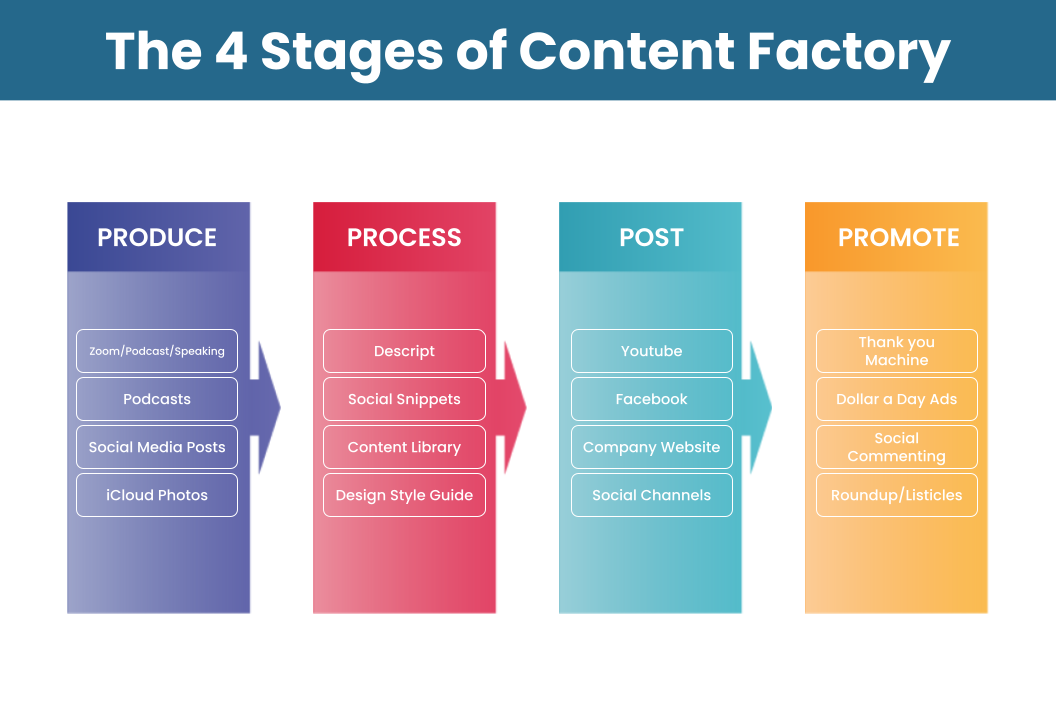
9. Use accelerated mobile pages, which is a plugin that we can use on WordPress, so it loads faster.
10. Use SEO tools like SemRush or ahrefs to determine the keyword difficulty, especially if it is a common name or there are ads running against it. You could also see how authoritative the other websites and webpages are that are using that name/keyword. For example, yourcontentfactory.com, which uses the keyword, Dennis Yu, has an authority score of 82.
11. If you’re not ranking on your name, then figure out what long tail things you could rank on. A long tail is your name plus a topic or your name plus a person’s name; for example, I can rank on Dennis Yu and Jeremy Duney, or on Dennis Yu and LinkedIn strategy, or whatever it is. This is an easier way to rank because you just need to have co-created content; it could be a podcast; you interview them, engage on Twitter or LinkedIn, and so on, and assemble these into your personal brand manager, which has your topic wheel.
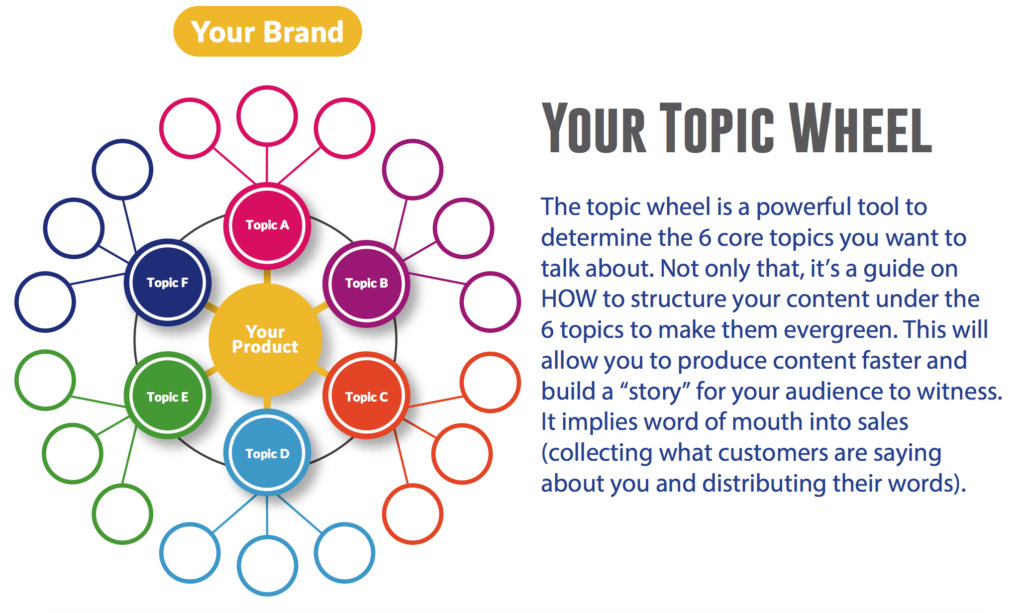
12. Post content like blog posts as a guest author on other websites that have high domain ranking. For example, www.free-ebooks.net has a domain ranking of 74. So, when you write an article on their blog page and link that back to your website or your webpage that is relevant to the article, that will generate a lot of traffic to your website and will increase your own domain ranking, which in turn will generate more engagement for your other content on your website.
13. Don’t link out just gratuitously to Google.com or Facebook.com. The only time we’re going to send outbound links is if it’s to a partner or a client or some kind of article that we really think is worthwhile. We’re not just going to randomly link to some article or whatever because that’s just bleeding the juice. You only have so much juice.
Conclusion
Ranking on a person’s name in digital marketing has numerous benefits, including increased online visibility, trust-building, brand management, networking opportunities, thought leadership establishment, and shedding light on unethical behavior.
By optimizing online content and utilizing effective strategies, individuals can control the information that appears in search results and position themselves as authorities in their field.
Building connections with high-ranking individuals and co-creating content can further enhance one’s authority and expand their network.
Additionally, utilizing tips such as personalized web search settings, subfolder placement, social media presence, knowledge panel claiming, content repurposing, and SEO tools can contribute to achieving higher rankings.
Ultimately, ranking on a person’s name in digital marketing can significantly impact personal branding, reputation management, and professional growth.

